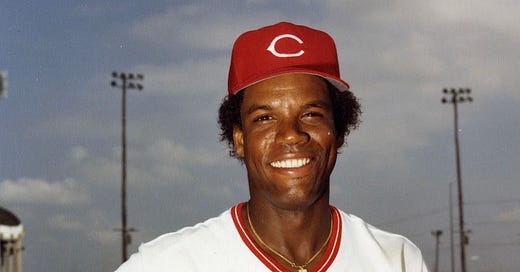Cesar Cedeño’s Time with the Cincinnati Reds: A Promising Trade with Mixed Results
In 429 games for the Reds, former all-star had 30 HR, 173 RBI, .265 BA, /323 OBP, .393 SLG and .716 OPS
On Dec. 18, 1981, the Cincinnati Reds made headlines by acquiring outfielder Cesar Cedeño from the Houston Astros in exchange for third baseman Ray Knight. At the time, the trade seemed like a calculated move for the Reds, who sought to infuse speed, power, and defensive skill into their outfield as they transitioned into a new era.
Cedeño arrived in Cincinnati with an impressive resume. A four-time All-Star and five-time Gold Glove winner, he had been one of baseball’s most dynamic players of the 1970s. As a young star with the Astros, C
edeño was electrifying. In 1972, as a 21-year-old, he hit .320 with an OPS+ of 162, followed by another .320 season in 1973 with an OPS+ of 152. However, those early peaks would prove difficult to replicate, and his later years—including his stint with the Reds—fell short of the brilliance he once displayed.
The Reds, meanwhile, were in a period of transition. After dominating the 1970s with the Big Red Machine, the team faced the challenge of rebuilding while maintaining competitiveness. Cedeño was brought in to help stabilize a roster reeling from the departures of George Foster, Ken Griffey, and Dave Collins. Though Ray Knight had been a fan favorite, his offensive struggles during the 1981 season Johnny Bench’s desire to play an infield corner made the trade seem like a logical gamble for Cincinnati.
Cedeño’s time with the Reds, from 1982 to 1985, featured glimpses of his former greatness but never lived up to expectations. His best season came in 1982, when he hit .289 with eight home runs, 57 RBIs, and 16 stolen bases. These numbers hinted at his skillset but were far removed from his prime, when he consistently delivered double-digit home runs and 80-plus RBIs.
Injuries also hindered Cedeño’s impact. Known for his blazing speed, nagging leg problems slowed him down, limiting his effectiveness both on the basepaths and in the outfield. His diminished physical capabilities, combined with the Reds’ overall struggles, made for a disappointing stretch. The team finished last in the National League West in both 1982 and 1983, unable to regain their former dominance.
By 1985, the Reds were beginning to rebuild around younger talent, and Cedeño was traded to the St. Louis Cardinals. His departure marked the end of a chapter that ultimately failed to meet the hopes tied to his arrival.
As for Ray Knight, the trade initially frustrated Reds fans, but his career found new life after he joined the New York Mets in 1984. Knight played a crucial role in the Mets’ 1986 World Series championship, cementing his legacy on a much larger stage.
Looking back, the Cedeño trade reflected the unpredictable nature of Major League Baseball deals. While the Reds hoped to recapture their former glory with his addition, it became clear that Cedeño’s best years were behind him. Despite the underwhelming results in Cincinnati, Cedeño’s legacy as one of the most electrifying players of the 1970s endures, a reminder of both the promise and unpredictability of baseball’s brightest stars.






I’ve found my way over here from Tower Topics. It’s nice to hear from a non-amusement park enthusiast side of you! And of course, as a Cincy native, I’m a ride or die Reds fan. I do need to brush up on my Reds history though!